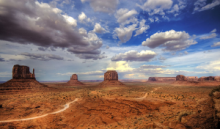Article
An Anglicized reference to the what the Navajo would call Diné Bikéyah, the traditional Navajo homeland, which is roughly demarcated by the four sacred mountains of the San Francisco Peaks or Dook’o’oslííd to the west, Mount Hesperus or Dibé Nitsaa to the north, Blanca Peak or Sisnaajiní to the east, and Mount Taylor or Tsoodzil to the south. More a concept and a state of mind than a specific territorial reference, "Navajo country" is a romanticized evocation of the high desert and red mesa landscapes that fill the Four Corners regions of the Southwestern U.S.
Tony Hillerman's use of the term Navajo country throughout his Navajo detective series also shares a resonance with the 19th-century use of the term "Indian Country," a somewhat pejorative reference to the always-receding lands west of the expanding U.S. frontier. Indian Country was wild, unsettled, and ripe for the taking, once the indigenous populations had been subdued and removed. Although Hillerman was an advocate for rather than an enemy of the peoples whose cultures he sketched into his novels, it's telling that one of his most used resources was an American Automobile Association map entitled "Indian Country," a detailed map of the roads and routes on the Navajo Reservation.
"Monument Valley, located on the Navajo Nation Reservation, on the southern border of Utah with northern Arizona, January 17, 2008" by Wolfgang Staudt is licensed under CC BY.
Manuscripts
References
Deloria, Jr., Cine and Clifford M. Lytle
1983 Indian Country. American Indians, American Justice. Austin: University of Texas
Press.
Sutton, Imre
1991 The Political Geography of Indian Country. American Indian Culture and Research
Journal 15(02).

